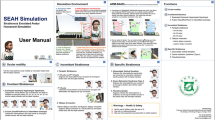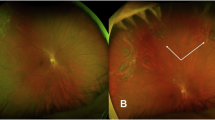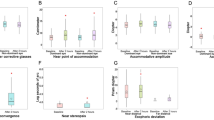Abstract
Introduction
Dissociated tests of strabismus provide valuable information for diagnosis and monitoring of ocular misalignment in patients with normal retinal correspondence. However, they are vulnerable to operator error and rely on a fixed head position. Virtual reality headsets obviate the need for head fixation, while providing other clear theoretical advantages, including complete control over the illumination and targets presented for the patient’s interaction.
Purpose
We compared the performance of a virtual reality-based test of ocular misalignment to that of the traditional Lees screen, to establish the feasibility of using virtual reality technology in ophthalmic settings in the future.
Methods
Three patients underwent a traditional Lees screen test, and a virtual reality headset-based test of ocular motility. The virtual reality headset-based programme consisted of an initial test to measure horizontal and vertical deviation, followed by a test for torsion.
Results
The pattern of deviation obtained using the virtual reality-based test showed agreement with that obtained from the Lees screen for patients with a fourth nerve palsy, comitant esotropia, and restrictive thyroid eye disease.
Conclusions
This study reports the first use of a virtual reality headset in assessing ocular misalignment, and demonstrates that it is a feasible dissociative test of strabismus.
Similar content being viewed by others
Log in or create a free account to read this content
Gain free access to this article, as well as selected content from this journal and more on nature.com
or
References
Lancaster WB . Detecting, measuring, plotting and interpreting ocular deviations. Arch Ophthalmol 1939; 22: 867–880.
Hess WR . I. Ein einfaches messendes Verfahren zur Motilitätsprüfung der Augen. Ophthalmologica 1916; 35: 201–219.
Lees VT . A new method of applying the screen test for inter-ocular muscle balance. Br J Ophthalmol 1949; 33 (1): 54–59.
Awadein A . A computerized version of the Lancaster red-green test. J AAPOS 2013; 17: 197–202.
Watts P, Nayak H, Lim MK, Ashcroft A, Al Madfai H, Palmer H . Validity and ease of use of a computerized Hess chart. J AAPOS 2011; 15: 451–454.
Timms C . The Lees screen test. Am Orthopt J 2006; 56: 180–183.
‘Oculus VR’ (2014). Oculus Rift. Available at http://www.oculusvr.com/rift/ (accessed 2 November 2016).
Peirce JW . Generating stimuli for neuroscience using PsychoPy. Front Neuroinformatics 2008; 2: 10.
Acknowledgements
We thank the Cambridge Eye Trust for funding the virtual reality headset and computer.
Author information
Authors and Affiliations
Corresponding author
Ethics declarations
Competing interests
The authors declare no conflict of interest.
Rights and permissions
About this article
Cite this article
Nesaratnam, N., Thomas, P. & Vivian, A. Stepping into the virtual unknown: feasibility study of a virtual reality-based test of ocular misalignment. Eye 31, 1503–1506 (2017). https://doi.org/10.1038/eye.2017.97
Received:
Accepted:
Published:
Issue date:
DOI: https://doi.org/10.1038/eye.2017.97
This article is cited by
-
Pistol: Pupil Invisible Supportive Tool in the Wild
SN Computer Science (2024)
-
Feasibility study of an automated Strabismus screening Test using Augmented Reality and Eye-tracking (STARE)
Eye (2023)
-
Usefulness of virtual reality-based training to diagnose strabismus
Scientific Reports (2021)



